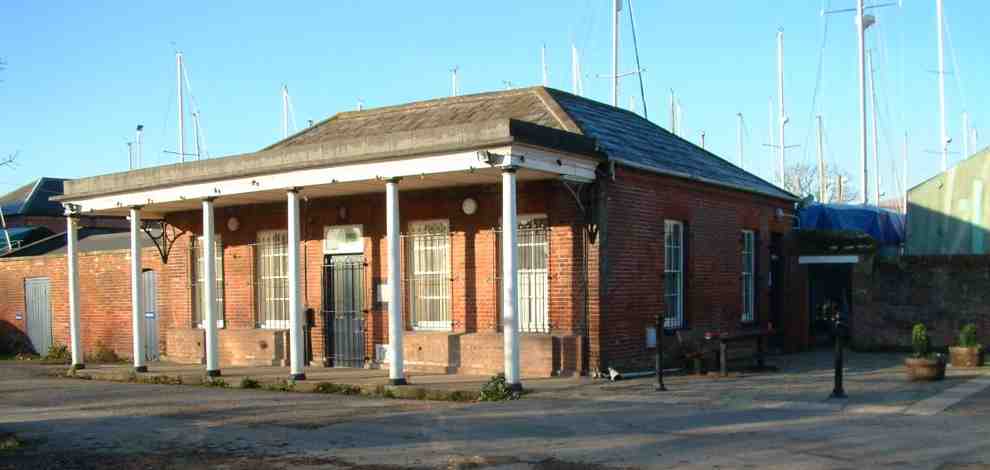MYC History
Club History part 1 by Peter Frost click to view a short film.
Club History part 2 by Peter Frost click to view a short film.
The Royal Naval Armaments Depot at Marchwood
Written by Adrian Turner
Opened in 1815
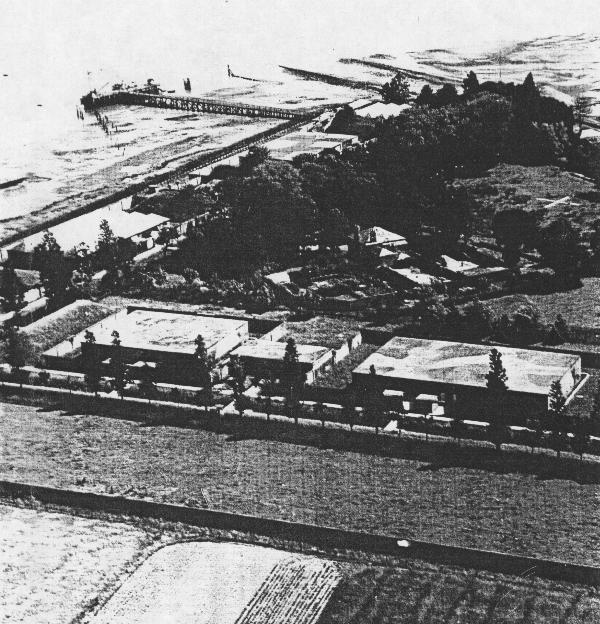
The picture shows the old jetty and the magazine buildings. Magazine 'A' is the building in line with the jetty. Ordnance House which is in the centre of the picture was occupied by the Commanding Officer.
To ensure that a country is well defended, its arms and munitions must be safely and securely stored. As long ago as the early Middle Ages, when England had no standing army or navy, the king's stock of arms was kept under the surveillance of the Keeper of the King's Wardrobe in the Tower of London.
As the art of gun design and the production of arms became more skilled, the status of the office was raised and from 1414 onwards there was a succession of 'Masters of our Works, Engines, Cannons and Other Kinds of Ordnance'. Towards the end of the sixteenth century, allegations of corruption together with the deteriorating quality of weaponry led to the appoint- ment of a Commission of Investigation and the re-shaping of the Office of Ordnance. In 1598 the department was put into the charge of The Great Master who controlled the disposition and storage of military and naval armaments and for the following 250 years, this administrative arrangement changed very little.
In about 1667, an ordnance depot was established in Portsmouth which immediately became one of the country's most important arms stores outside the Tower of London. Explosives were kept in the Square Tower at the south-west end of Portsmouth High Street, but during the next century, fears grew over the proximity of the magazine to the heavily Populated town and in the 1760s this culminated in a successful public petition for its removal.
Weapons and hardware continued to be stored in the Square Tower, but during the 1770s, all the explosives were moved across the harbour for storage in the massive gunpowder magazine at Priddy's Hard - the oldest of the four depots making up the complex of R.N.A.D. Gosport. Priddy's Hard was built in 1771, and although six thousand barrels of gunpowder could be stored there, it was necessary to disperse the ammunition and gunpowder in case the depot ever came under attack. Satellite magazine stores were built to serve this purpose and one of these was the Royal Naval Armaments Depot at Marchwood.
R.N.A.D. Marchwood was built some 40 years after Priddy's Hard came into use and was opened in 1815. Historically this date was significant as it was not only a time when Britain was undergoing industrialization and consequent social changes, but it was also in this year that Britain defeated France at Waterloo, making her one of the strongest nations in Europe. Priority was naturally given to maintaining this superiority and ensuring that the country remained well protected.
The building of this small depot at Marchwood may have appeared insignificant in the grand scale of things but its role was to prove important during its 146 year life. Plans to build a satellite magazine on the west side of the River Test were initiated in 1812 under the instruction of the Inspector General of Ordnance.
The site at Marchwood was purchased by the Ordnance Office from Sir Charles Mills for 1,200 and three years later, staffed by a storekeeper named R.B. Ady, a Foreman and two Watchmen, a three magazine depot capable of storing 21,000 barrels of gunpowder, was opened. Being highly dangerous it was imperative that the gunpowder was securely stored, both to minimise the risk of accident and to keep it out of the reach of would-be thieves.
Consequently each magazine had to be solidly constructed with 21 inch thick brick walls which were double skinned and had ventilation ports. The massive roofs were of half inch thick slates laid on top of clay tiles, with the soffits finished in one inch thick elm boarding. To avoid the obvious hazard from sparks, all metal work was non-ferrous and even the one and a half inch thick coffered floors were constructed using wooden pegs instead of nails. Copper was used for other metal surfaces.
Outside, the magazines were surrounded by brick wails 11 feet high and 15 inches thick. They were also separated by traverses of brick walls and blast banks of earth 21 feet high. In addition to the three magazines, the Depot consisted of an examining laboratory with two rooms, a shifting house, a cooperage, two store rooms, a boathouse, a powder pier and a hard. There were also barracks and offices.
It was necessary for security at Marchwood to be strict and in 1819 military sentries were introduced to the site. During the next 72 years, while Marchwood was under the jurisdiction of the Board of Ordnance and, later, the War Office, the depot was under a 24 hour guard. This was carried out by four military sentries and two watchmen who were labourers at the depot. The exclusive duty of one of these watchmen would be to patrol the river bank behind the magazines.
The strength of the military presence varied over the years. The first detachment of the Royal Artillery to be deployed at Marchwood in 1819 consisted of one sergeant with 12 N.C.0s. and men. The detachment in 1846 had one sergeant and fourteen gunners and in 1891, there were two officers, a company of the Rifle Brigade and a surgeon with army medical staff. The number of men posted to the depot at any particular time is probably an indication of the volume of gunpowder being stored there.
By the start of the 1850s, activity at Marchwood appears to have diminished, as between October 1850 and March 1854, the magazines were empty and depot houses were let to coast-guards and civilians. However, Britain's entry into the Crimean War (March 1854 - February 1856) immediately led to the re-commissioning of the magazines and in 1856 four new magazines were built. These were handed over to the War Office, which replaced the now abolished Ordnance Office, by the Royal Engineer on July lst l857. The establishment site now covered 7 acres and became triangular in shape.
Like the residents of Portsmouth a hundred years earlier, the people of Southampton were concerned about an armaments depot being so close to their homes. In January 1876, when Marchwood was well stocked and fears were at their worst, the Committee for the Transport and Storage of Powder was petitioned and the removal of the depot was demanded. The Committee's president, Colonel C.M. Younghusband reassured the people of Southampton that they were in no danger and maintained there was nothing to justify the removal of the establishment from the neighbourhood.
The Secretary of state for War agreed that under no circumstances could he consent to the removal of the armaments depot. At about this time, the stock at Marchwood ceased to be exclusively gunpowder, and in 1877 one magazine was allocated for small arms. In 1892 a second magazine was set aside for Q.F. ammunition.
Naval vessels brought the consignments of gunpowder along Southampton Water to Marchwood where they were delivered at the pier head. The barrels were then, three at a time, transported on magazine barrows along the pier to the rolling stage for inspection by the cooper. The barrels were then transferred to flat bottomed barges and ferried along the canal to the magazines. Casual labour was sometimes employed to help convey the barrels to and from the magazines. Throughout the depot's life, few changes were made to the unloading and storage procedures. Every effort was made to avoid accidents and spillages and over the years strict regulations were enforced. For example, no barrels were ever opened in the magazines but were taken to the Examining Rooms for investigation. The barrels were constantly examined for faults such as slackness in the hooping and if any defective barrels were discovered, they were immediately taken to the cooper to be repaired. The magazine floors were swept after every arrival and dispatch of gunpowder and any areas that the gunpowder had been carried over were sprinkled with water.
There were also strict rules concerning the men who worked in the depot. The cooper and labourers for instance were frequently assembled in the shifting room where their clothing was searched for pipes and matches. Before they were allowed to enter the magazines they had to change into jerseys and woollen drawers which they wore under 'duck' frocks and trousers. Working parties employed from 1925 onwards were also carefully searched for anything of a dangerous nature. They too wore prescribed clothing and special magazine shoes.
Royal Marine Light Infantry in Marching Order
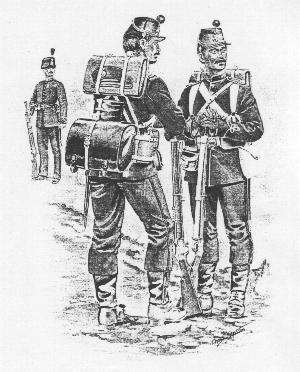
Two officers, 40 N.C.0s. and men of the Royal Marines Light Infantry were detached to Marchwood under the authority of Captain W.S. Cox. Life for these men appears to have been relatively congenial compared to the rigours of normal marine life. The officers, for example, were granted a special allowance of Is 6d a day in lieu of provisions, fuel and mess expenses.
No.167 Admiralty Orders in Council 9th May 1892
ALLOWANCE IN LIEU OF PROVISIONS TO OFFICERS, ROYAL MARINES, SERVING AT NAVAL POWDER MAGAZINES.
Whereas a detachment of Royal Marines is now stationed at Marchwood Powder Magazine in consequence of its transfer from the War Office to the Admiralty. We are of opinion that the Officers serving with the detachment there, and all other Royal Marine Officers on detached duty of a similar character, should receive a special allowance of Is. 6d. a day, in lieu of Provisions, Fuel, or Lights, and in aid of Mess expenses. We beg leave therefore humbly to recommend that Your Majesty will be graciously pleased by, Your Order in Council to sanction the issue of this allowance as from the 1st September 1891, or such other date subsequent thereto as the Officers of the Royal Marines may be employed on detached duty at any of the Naval Powder Magazines, The Lords Commissioners of Your Majesty's Treasury have signified their concurrence in this proposal.
An Officer of The Royal Marines Light Infantry
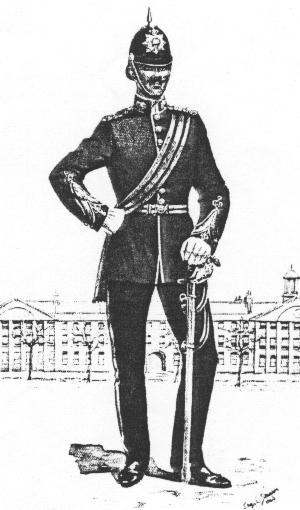
It was during the time of the Marines' residence that a windmill to supply fresh water was constructed at the depot. The machine, 16 feet and supported on a 70 foot high square steel trellis, was purchased from John Wallis Titt's Iron Works in Warminster in 1873 for the sum of 155. It was in operation by the following year. For the next four years the windmill was in use continuously but it appears to have been the cause of grievance on more than one occasion.
In a letter dated 9th November 1898, Captain Cox complained to the Naval Officer at Portsmouth that for some considerable time the water has not accumulated in the tank to the slightest degree. Only three months later Captain Cox reported. It has been found almost impossible and extremely dangerous to attempt to stop the windmill from working during a storm or in a gale of wind.
At the turn of the century, the magazines were full to capacity, acting as a reserve unit for Portsmouth. Security was now undertaken by the Dockyard Division of the Metropolitan Police. At the outbreak of war in 1914, ammunition and the bulk of the Navy's gunpowder were stored at Marchwood, but between 1916 and 1918, all the magazines were emptied so that cordite could be stored there instead. This period saw a huge increase in the number of staff, from 21 at the beginning of the war to 103 in 1918.
During the 1920s, due to the reorganization of the Metropolitan Police there was yet another change in security arrangements when it was decided that they should discontinue their service at Marchwood. Because the reorganization was so extensive, it was introduced piecemeal, beginning with the country's arms depots then moving onto the dockyards. Since the Royal Marines had often undertaken a security role at depots and dockyards in the past, they were a natural choice to replace the Metropolitan Police. In 1923, the Royal Marine Police returned to Marchwood, staying there until they were absorbed into the Admiralty Civil Police Force in 1949.
During the Second World War, Marchwood again acted as a reserve unit but this time for Priddy's Hard at Gosport and was the main depot for explosives for the reserve fleet. On the night of 19th June 1940, however, the depot suffered an air attack and 200 incendiary bombs caused the destruction of four of Marchwood's magazines and a full storehouse. About 229,000 rounds of Oerlikon ammunition together with 127,000 lbs of cordite were detonated and the huge explosions seriously damaged cottages a hundred yards away. Nine thousand empty crates in the storehouse were also lost.
A second attack in December of that year destroyed yet another magazine but by January 1942 all of the buildings destroyed in the air raids had been rebuilt.
During the post war period Marchwood continued to provide storage space for the overflow of ammunition from Priddy's Hard. It also housed shells and small arms for coastal minesweepers and anti-aircraft fire. In the late 1950s the Navy began to cut down on the size of the Fleet, weaponry had become refined and the location of Marchwood was now considered to be geographically unsuitable.
Marchwood Yacht Club
Aerial views of the jetty and showing the buildings that are now the club room and committee room. As you can see the boat compound was full of trees which surrounded Ordnance House. The name can still be seen on the pillars between the club and committee room.
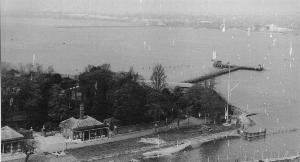
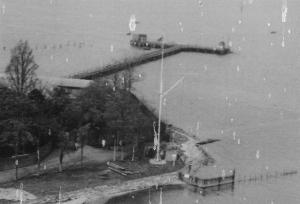
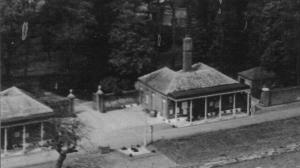
Club House to the left with Committee Room on the right
Piling for the new power station in 1953
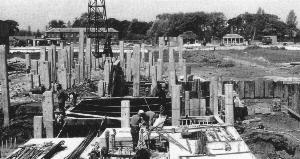
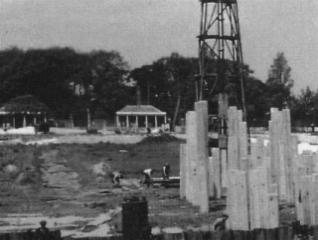
(Club house and Committee Room in the background)
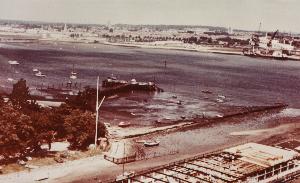
Power Station being built with MYC Jetty in background at low tide. The jetty was demolished when the container dock was built. The jetty had bronze rails running the full length which were used to move the high explosives. The old jetty ran out at 90 to Magazine 'A' and the Receiving Room. The Receiving Room is still on the foreshore. Dinghies were stored and launched from the jetty steps. The old flag pole was removed because of rot and the base support structure can now be seen at Hythe Marina.
Boats were lifted over the wall from the creek and stored on the grass strip in front of the clubroom. Two cranes used to drive down the narrow public road access and every boat was lifted out in one weekend.
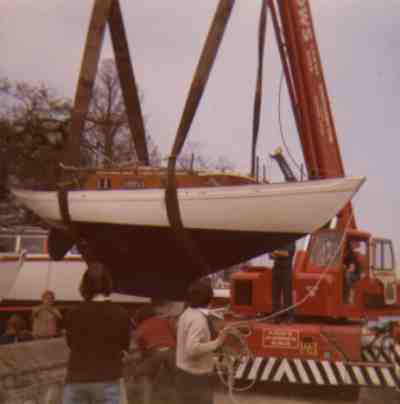
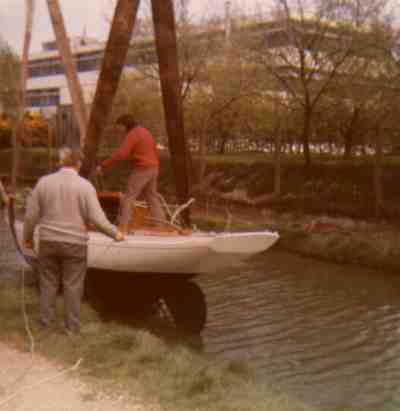
Zara Seaview Mermaid conversion owned by Adrian & Mike Turner in 1973.
1983
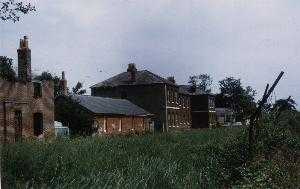
The single storey building used to be the first clubroom. You now drive through this when approaching the club.
1998
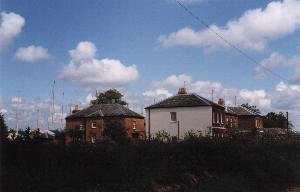
MYC Clubroom
